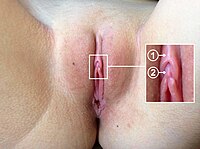
Photo from wikipedia
BACKGROUND Sexual harassment is defined as unwelcome behaviors or obscene remarks that affect an individual's work performance or create an intimidating, hostile, or offensive environment. It is known to be… Click to show full abstract
BACKGROUND Sexual harassment is defined as unwelcome behaviors or obscene remarks that affect an individual's work performance or create an intimidating, hostile, or offensive environment. It is known to be more pervasive in male-dominated workplaces and flourishes in a climate of tolerance and culture of silence. We sought to examine its prevalence in faculty of vascular surgery training programs, to identify factors associated with occurrence, to determine reporting barriers, and to identify any gender bias that exists. METHODS An anonymous survey consisting of questions on gender bias and sexual harassment was e-mailed to vascular surgery faculty members at 52 training sites in the United States. The survey asked about type, perpetrators, and locations; why and how the practice occurs; reporting mechanisms and barriers to reporting; and demographic information. Descriptive and univariate analyses were performed. RESULTS Of 346 invitations sent, 149 recipients (43%) completed the survey. Of respondents, 48 of 149 (32%) thought harassment occurred more commonly in surgical specialties with historical male dominance, citing ignoring of behavior and hierarchy/power dynamics as the most common reasons for its occurrence; 61 of 149 (41%) reported having experienced workplace harassment, with unwanted sexually explicit comments or questions and jokes, being called a sexist slur or nickname, or being paid unwanted flirtation as the most common behaviors. Harassment was high in both men and women, although women had a higher likelihood of being harassed (67% of women respondents vs 34% of men respondents; P = .001) and on average had experienced 2.6 (of 11) types of harassment. The majority of harassment came from hospital staff, although women were more likely to receive harassment from other faculty. Despite that 84% of respondents acknowledged known institutional reporting mechanisms, only 7.2% of the harassing behaviors were reported. The most common reasons for not reporting included feeling that the behavior was "harmless" (67%) or "nothing positive would come of it" (28%). Of the respondents, 30% feared repercussions or felt uncomfortable identifying as a target of sexual harassment, and only 59% would feel comfortable discussing the harassment with departmental or divisional leadership. In examining workplace gender disparity, female surgeon responses differed significantly from male surgeon responses in regard to perceptions of gender differences. CONCLUSIONS A significant number of faculty of vascular surgery training programs have experienced workplace sexual harassment. Whereas most are aware of institutional reporting mechanisms, very few events are reported and <60% of respondents feel comfortable reporting to departmental or divisional leadership. Female vascular surgeons believe gender influences hiring, promotion, compensation, and assumptions of life goals. Further work is necessary to identify methods of reducing workplace sexual harassment and to optimize gender disparity in vascular surgery practice.
Journal Title: Journal of vascular surgery
Year Published: 2020
Link to full text (if available)
Share on Social Media: Sign Up to like & get
recommendations!